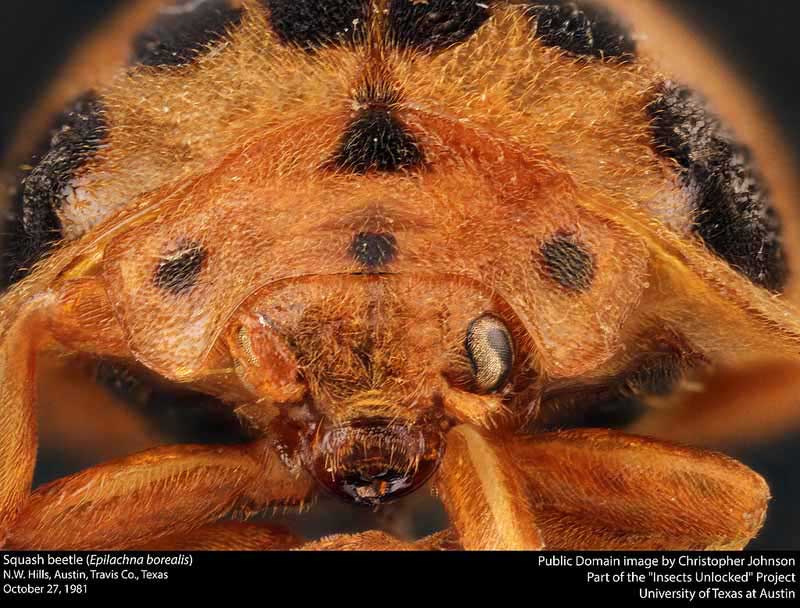
Superregnum: Eukaryota
Cladus: Unikonta
Cladus: Opisthokonta
Cladus: Holozoa
Regnum: Animalia
Subregnum: Eumetazoa
Cladus: Bilateria
Cladus: Nephrozoa
Cladus: Protostomia
Cladus: Ecdysozoa
Cladus: Panarthropoda
Phylum: Arthropoda
Subphylum: Hexapoda
Classis: Insecta
Cladus: Dicondylia
Subclassis: Pterygota
Cladus: Metapterygota
Infraclassis: Neoptera
Cladus: Eumetabola
Cladus: Endopterygota
Superordo: Coleopterida
Ordo: Coleoptera
Subordo: Polyphaga
Infraordo: Cucujiformia
Superfamilia: Coccinelloidea
Familia: Coccinellidae
Subfamilia: Coccinellinae
Tribus: Epilachnini
Genus: Epilachna
Species: Epilachna borealis
Name
Epilachna borealis (Fabricius, 1775)
Original combination: Coccinella borealis Fabricius, 1775: 82
Type locality: North America
Lectotype: female ♀, ZMUC (designated by Li, 1993: 222)
References
Primary references
Fabricius, J.C. 1775. Systema entomologiae, sistens insectorum classes, ordines, genera, species, adiectis synonymis, locis, descriptionibus, observationibus. Libraria Kortii, Flensburgi et Lipsiae. xvi+ 832 pp. DOI: 10.5962/bhl.title.36510. BHL. Reference page.
Mulsant, E. 1850. Species des Coléoptères trimères sécuripalpes. Annales des Sciences Physiques et Naturelles, d’Agriculture et d’Industrie, Lyon (2) 2: 1–1104. BHL Reference page.
Li C.-S. 1993. Review of the Australian Epilachninae (Coleoptera: Coccinellidae). Journal of the Australian Entomological Society 32(3): 209-224. DOI: 10.1111/j.1440-6055.1993.tb00577.x Reference page.
Epilachna borealis is a species of beetle that can commonly be found in the eastern United States. It is yellow with seven large black spots on each elytron and four small black spots on the pronotum. The species feeds on cucurbitaceous plants. Its common name is squash beetle.[1] It is often mistaken for a ladybug or a cucumber beetle because of its similar appearance.
Biology
The beetle lays a cluster of small yellow eggs on the leaf surfaces of cucurbitaceous plants.[2] Both adult beetles and larvae feed on leaf tissue in between veins,[3] and usually start by producing a semi-circle trench around their intended feeding area.[4] Adult squash beetles can also be found feeding on the rind of pumpkins and squash later in the season.[5]
References
The Common Insects of North America by Lester A. Swan and Charles S. Papp, 1972, page 412
Boucher, Jude (2014). "Squash Beetle". UConn Extension. Retrieved April 27, 2020. "'Eggs are yellow and stand erect on the leaf surface in a loose cluster with space between each egg.'"
"Squash Beetle - Vegetables". University of Maryland Extension. Retrieved April 27, 2020.
Boucher, Jude (2014). "Squash Beetle". UConn Extension. Retrieved April 27, 2020. "'Both adults and larvae start feeding by producing a trench around the leaf tissue that they intend to consume.'"
Boucher, Jude (2014). "Squash Beetle". UConn Extension. Retrieved April 27, 2020. "'Late in the season, large numbers of adult beetles may be found feeding on the rind of a single or many adjacent squash and pumpkin fruit.'"
Retrieved from "http://en.wikipedia.org/"
All text is available under the terms of the GNU Free Documentation License

